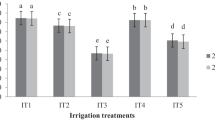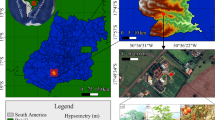Abstract
Tomato (Solanum lycopersicon esculentum L.) was grown on rockwool at different EC-regimes. The experiments were carried out under different climatic conditions. The EC-regimes were realized by varying the quantities of nutrient elements supplied. The ratios between the elements were kept constant.
The maximum value of the EC in the root environment at which no yield depression occurred was about 2.5 dS.m−1 at 25°C. Higher EC-values decreased the yield with 5 to 7% per dS.m−1. However, a decrease of 10% was found in an experiment with a very high humidity level. High EC-values under poor light conditions did not affect yields adversely to any extent. It could therefore be concluded that in calculations of EC-induced yield reductions from data of experiments with varying EC-values, both the lengths of the EC-intervals and the light intensity during the intervals have to be taken into account.
Fruit quality was improved by increased EC-values. Potassium contents in the leaves were increased and calcium and magnesium contents were decreased. The effect on the nitrate and the phosphate contents was different for young and old leaves.
Similar content being viewed by others
References
Bes S S de 1986 A summary of methods for analysing glasshouse crops. Glasshouse Crops Research Station, Naaldwijk.
Graves C J 1983 The nutrient film technique. Hort. Rev. 5, 1–44.
Hoffman G J and Rawlins S L 1971 Growth and water potential of root crops as influenced by salinity and relative humidity. Agron. J. 63, 877–880.
Magistad O C, Ayers A D, Wadleigh C H and Gauch H G 1943 Effect of salt concentration, kind of salt, and climate on plant growth in sand cultures. Plant Physiol. 18, 151–166.
Meiri A 1984 Plant response to salinity: Experimental methodology and application to the field.In Soil Salinity under Irrigation. Processes and Management. Eds. Shainberg J and Shalhevet J, pp 264–297. Springer-Verlag, Berlin-Heidelberg.
Sonneveld C and Welles G W H 1984 Growing vegetables in substrates in The Netherlands. Proceedings Sixth Intern. Congress Soilless Culture, Lunteren, 613–632.
Thomson W W 1985 Membrane organization and function in seed germination and salinity.In Soil and Plant Interactions with Salinity. Ed. J Letey. Agric. Exp. Sta. Univ. of California, Special Publication 3315, 1–5.
Author information
Authors and Affiliations
Rights and permissions
About this article
Cite this article
Sonneveld, C., Welles, G.W.H. Yield and quality of rockwool-grown tomatoes as affected by variations in EC-value and climatic conditions. Plant Soil 111, 37–42 (1988). https://doi.org/10.1007/BF02182034
Received:
Revised:
Issue Date:
DOI: https://doi.org/10.1007/BF02182034




